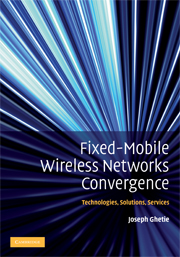Book contents
- Frontmatter
- Contents
- Disclaimer
- How the Book is Organized
- List of Figures
- List of Tables
- Preface
- Acknowledgments
- Acronyms
- Part I Wireless Communications: Networking and Management
- Part II Cellular Mobile Radio Networking and Management
- Part III Fixed Wireless Technologies: Networking and Management
- 6 Wireless Local Area Networking
- 7 Wireless Personal Area Networking
- 8 Wireless Metropolitan Area Networking
- 9 Wireless Near-Field Sensor Networking
- Part IV Fixed Wireless Cellular Mobile Networks Convergence and Integration
- Part V Fixed Wireless Cellular Mobile Networks Convergence: Standardized Networking Solutions
- Part VI Fixed-Mobile Convergence Services, Industry Trends, and Implementation Issues
- References
- Index
7 - Wireless Personal Area Networking
from Part III - Fixed Wireless Technologies: Networking and Management
Published online by Cambridge University Press: 21 August 2009
- Frontmatter
- Contents
- Disclaimer
- How the Book is Organized
- List of Figures
- List of Tables
- Preface
- Acknowledgments
- Acronyms
- Part I Wireless Communications: Networking and Management
- Part II Cellular Mobile Radio Networking and Management
- Part III Fixed Wireless Technologies: Networking and Management
- 6 Wireless Local Area Networking
- 7 Wireless Personal Area Networking
- 8 Wireless Metropolitan Area Networking
- 9 Wireless Near-Field Sensor Networking
- Part IV Fixed Wireless Cellular Mobile Networks Convergence and Integration
- Part V Fixed Wireless Cellular Mobile Networks Convergence: Standardized Networking Solutions
- Part VI Fixed-Mobile Convergence Services, Industry Trends, and Implementation Issues
- References
- Index
Summary
Wireless PAN Architecture
A typical residential network infrastructure, shown in Figure 7.1, consists of three types of network: a local wired loop that connects the residence to the serving telephone company (voice/data or xDSL), a coaxial cable that connects the residence to a cable company (video, data, voice with an alternative for video broadcast using a satellite network), and the AC power lines that connect the residence to the power company.
A home network, also known as a Personal Area Network (PAN), is intended to integrate and standardize the use and interaction of home end-devices and appliances. PAN facilitates and supports the interconnection of multiple computing data devices and peripherals (printers, scanners, digital cameras, video cameras), voice and video communications, music distribution (MP3 and CD players), and use of surveillance devices to command and control appliances (meter reading, temperature and light regulation). Wireless Personal Area Network (WPAN) is the new generation of PANs that uses wireless communication to connect the PAN components. A typical WPAN infrastructure consists of a concentration point in the form of a Residential Gateway (RG) with a connectivity component to a broadband network in the form of a Network Gateway (NG). This is shown in Figure 7.2.
Both wired and wireless communications capabilities can be used for connectivity between the RG and the NG. Connection types include unshielded twisted pairs, coaxial cable, fiber optic, or power lines.
- Type
- Chapter
- Information
- Fixed-Mobile Wireless Networks ConvergenceTechnologies, Solutions, Services, pp. 149 - 171Publisher: Cambridge University PressPrint publication year: 2008



